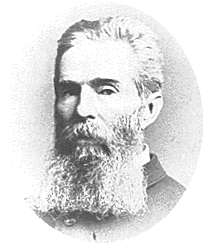


Herman Melville was born in New York City into an established merchant family. His father became bankrupt and insane, dying when Melville was 12. A bout of scarlet fever in 1826 left Melville with permanently weakened eyesight. He attended Albany (N.Y.) Classical School in 1835. He left the school and was largely autodidact, devouring Shakespeare as well as historical, anthropological, and technical works. From the age of 12, he worked as a clerk, teacher, and farmhand. In search of adventures, he shipped out in 1839 as a cabin boy on the whaler Achushnet. He joined later the US Navy, and started his years long voyages on ships, sailing both the Atlantic and the South Seas. During these years he was a clerk and bookkeeper in general store in Honolulu and lived briefly among the Typee cannibals in the Marquesas Islands. Another ship rescued him and took him to Tahiti.
Typee, an account of his stay with the cannibals, was first published in Britain, like most of his works. The book sold roughly 6,000 copies in its first two years. Its sequel, OMOO (1847), was based on his experiences in Polynesian Islands, and gained a huge success as the first one. Throughout his career Melville enjoyed a rather higher estimation in Britain than in America. His older brother Gansevoort held a government position in London, and helped to launch Melville's career. From his third book, MARDI AND A VOYAGE THITHER (1849), Melville started to experience the unpredictable turns of popular acclaim.
In 1847 Melville married Elisabeth Shaw, daughter of the chief justice of Massachusetts. After three years in New York, he bought a farm, "Arrowhead", near Nathaniel Hawthorne's home at Pittsfield, Massachusetts, and became friends with him for some time. Melville had almost completed Moby-Dick when Hawthorne encouraged him to change it from a story full of details about whaling, into an allegorical novel.
Inspired by the achievement of Hawthore, Melville wrote his masterpiece, Moby-Dick. He worked at his desk all day not eating anything till 4 or 5 o'clock, and bursting with energy he shouted: "Give me Vesuvius' crater for an inkstand!" When the novel was published, it did not bring him the fame he had acquired in the 1840s. Readers of Typhee and Omoo were not expecting this kind of story, and its brilliance was only noted by some critics. Through the story Melville meditated questions about faith and the workings of God's intelligence. He returned to these meditations in his last great work, BILLY BUDD, a story left unfinished at his death. REDBURN (1849) and WHITE-JACKED (1850) Melville wrote to get money, comparing his work to "sawing wood".
Moby-Dick was misunderstood by those who read and reviewed it and it sold only some 3,000 copies during Melville's lifetime. The book can be read as a thrilling sea story, an examination of the conflict between man and nature—the battle between Ahab and the whale is open to many interpretations. It is a pioneer novel but the prairie is now sea. Jorge Luis Borges has seen in the universe of Moby-Dick "a cosmos (a chaos) not only perceptibly malignant as the Gnostics had intuited, but also irrational, like the cosmos in the hexameters of Lucretius." (from The Total Library, 1999) Clare Spark has connected in Hunting Captain Ahab (2001) different interpretations with changing political atmosphere—depending on the point of view Ahab has been seen as a Promethean hero or a forefather of the twentieth-century totalitarian dictators. The director John Huston questions in his film version (1956) which one, Ahab or the whale, is the real Monster.
PIERRE (1852), a Gothic romance and psychological study based on the author's childhood, was a financial and critical disaster. Melville's stories in Putnam's Monthly Magazine reflected the despair and the contempt for human hypocrisy and materialism. Among the stories were 'The Scrivener' (1853), 'The Encantadas' (1854) and 'Benito Cereno' (1855). 'Batleby' was a story about a man, who confronts life with an Everlasting Nay—"I would prefer not to," is his quiet defense against onrushing materialism of the day.
THE CONFIDENCE MAN (1857), Melville's last novel, was a harsh satire of American life set on a Mississippi River steamboat. After 1857 he wrote only some poetry. To recover from a breakdown, he undertook a long journey to Europe and the Holy Land. CLAREL (1876), a long poem about religious crisis, was based on this strip, and reflected his Manichean view of God. Subsequent works were privately printed and distributed among a very small circle of acquaintances.
After unsuccessful lecture tours in 1857-60, Melville lived in Washington, D.C. (1861-62). He moved to New York, where he was appointed customs inspector on the New York docks. This work secured him a regular income. Melville's later works include BATTLE-PIECES AND ASPECTS OF THE WAR (1865), privately printed JOHN MARR AND OTHER SAILORS (1888), and TIMOLEON (1891). Melville's death on September 28, 1891, in New York, was noted with only one obituary notice. His unfinished work, Billy Budd, Foretopman, remained unpublished until 1924.
Selected works:
Comments and Questions about this Web site: zenana@writeme.com